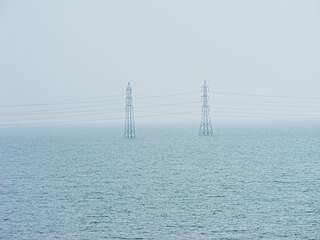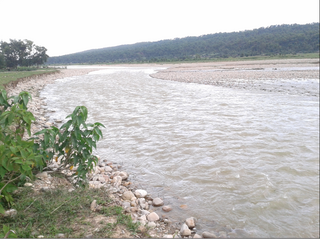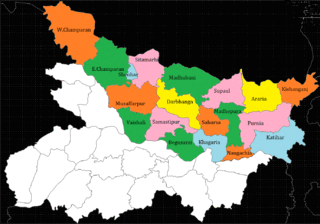
An alluvial fan is an accumulation of sediments that fans outwards from a concentrated source of sediments, such as a narrow canyon emerging from an escarpment. They are characteristic of mountainous terrain in arid to semiarid climates, but are also found in more humid environments subject to intense rainfall and in areas of modern glaciation. They range in area from less than 1 square kilometer (0.4 sq mi) to almost 20,000 square kilometers (7,700 sq mi).

Saharsa is a city and municipal corporation in the Saharsa District in the eastern part of the state of Bihar, India. It is situated near the eastern banks of the Kosi River. It serves as the administrative headquarters for Saharsa District and is also the Divisional headquarters of the Kosi Division.
Supaul is a town and a municipality that is headquarters of Supaul district in the Indian state of Bihar. Supaul is the administrative headquarters of this district. There Are 11 block under the Supaul district Supaul, Kishanpur, Saraigarh-Bhaptiyahi, Pipra, Triveniganj, Raghopur, chhatapur, Nirmali, Marauna, Basantpur and pratapganj.

Supaul district is one of the thirty-eight districts of Bihar, India. The town Supaul is the district's administrative headquarters. The district, which was split from the former Saharsa district on 14 March 1991, occupies 2,410 km2 (931 sq mi).

Kosi division is an administrative geographical unit of Bihar state of India. Saharsa is the administrative headquarters of the division. Currently (2022), the division consists of Saharsa district, Madhepura district, and Supaul district.

The Kosi or Koshi is a transboundary river which flows through China, Nepal and India. It drains the northern slopes of the Himalayas in Tibet and the southern slopes in Nepal. From a major confluence of tributaries north of the Chatra Gorge onwards, the Kosi River is also known as the Saptakoshi for its seven upper tributaries. These include the Tamur River originating from the Kanchenjunga area in the east and Arun River and the Sun Kosi from Tibet. The Sun Koshi's tributaries from east to west are the Dudh Koshi, Likhu Khola, Tamakoshi River, Bhote Koshi and Indravati. The Saptakoshi crosses into northern Bihar, India where it branches into distributaries before joining the Ganges near Kursela in Katihar district. The Kosi is the third-largest tributary of the Ganges by water discharge after the Ghaghara and the Yamuna.
Nirmali is a town and a notified area in Supaul district in the Indian state of Bihar.
The 2008 Indian floods were a series of floods in various states of India during the 2008 monsoon season. The floods mostly affected the western regions of Maharashtra state and Andhra Pradesh as well as northern Bihar. In India, the monsoon season generally lasts from June to September.

The Koshi Barrage is a sluice across the Koshi river that carries vehicular, bicycle, and pedestrian traffic between Saptari district and Sunsari district of Nepal. It is near the International border with India. It was built between 1958 and 1962 and has 56 gates. It was constructed after the Koshi Agreement was signed between the Government of Nepal and India on April 25, 1954. The barrage was designed and built by Joseph and Company Limited, India. The Koshi Tappu Wildlife Reserve is roughly 3–4 miles north of the barrage.
The 2007 Bihar flood occurred in August 2007 in the east Indian state of Bihar. It was described by the United Nations as the worst flood in the living memory of Bihar. Although annual floods are common in Bihar, heavier than usual rainfall during the monsoon season that year led to increasing water levels. By 3 August, the estimated death toll was 41 people, and 48 schoolgirls were marooned in a school in the Darbhanga district. By 8 August, the flooding had impacted an estimated 10 million people in Bihar. Army helicopters delivered food packets to residents, and 180 relief camps were established. By 10 August, aid workers in Bihar reported a dramatic increase in people with diarrhea and by 11 August, flood-related deaths were still occurring. The total number of deaths recorded in the 2007 Bihar floods was more than 1,300, the highest death toll in the state since the 1987 Bihar floods, in which more than 2,500 deaths were reported.

Bihar is India's most flood-prone state, with 76% of the population of North Bihar living under the recurring threat of devastating flooding. Bihar makes up 16.5% of India's flood-affected area and contains 22.1% of India's flood-affected population. About 73.06% of Bihar's geographical area, 68,800 square kilometres (26,600 sq mi) out of 94,160 square kilometres (36,360 sq mi), is affected. Each year, floods kill many and damage livestock and other assets worth millions. In total, floods have claimed 9,500 lives since the government started publishing figures in 1979. North Bihar districts are vulnerable to at least five major flood-causing rivers during monsoon – the Mahananda, Koshi, Bagmati, Burhi Gandak, and Gandak rivers – which originate in Nepal. Some South Bihar districts have also become vulnerable to floods, from the Son, Punpun, and Phalgu rivers. The 2013 flood affected over 5.9 million people in 3,768 villages in 20 districts in the state. The 2017 flood affected 19 districts in North Bihar, killing 514 people and affecting over 17 million.
The Koshi embankments were built in late 1950s to retain the Kosi River which is a transboundary river between Nepal and India and is one of the largest tributaries of the Ganges. It was conceptualised during the first Bihar Government of CM Shri Babu and his deputy Anugraha Babu. According to the agreement with Nepal, the responsibility of maintaining these embankments was vested in the Government of Bihar.

Nitish Mishra is an Indian politician hailing from eastern Indian state of Bihar, India. He represented Jhanjharpur assembly constituency in Madhubani district in 13th, 14th and 15th Bihar Legislative Assembly. Presently, he is member of 17th Bihar Legislative Assembly from Jhanjharpur and also Vice President, BJP - Bihar.

The National Disaster Response Force (NDRF) is an Indian specialized force constituted "for the purpose of special response to a threatening disaster situation or disaster" under the Disaster Management Act, 2005. The "Apex Body for Disaster Management" in India is the National Disaster Management Authority (NDMA). The Chairman of the NDMA is the Prime Minister.

The Kamala River originates in Nepal and flows through the Indian state of Bihar.
Kunauli is a town located in the Supaul district of Bihar, India on the border of Nepal's Saptari District.

North Bihar is a term used for the region of Bihar, India, which lies north of the Ganga river.
Khajuraha is an ancient northern Indian village situated in Saharsa district of Bihar. It is one of the largest panchayats of the state, both by area and population. The origin of the name Khajuraha is unknown. Khajuraha is part of Sonbarsa Raj block of Saharsa district. Some of the neighbouring places include Chandiasthan Gazipaita, Biratpur, Lagma, and Golma. Saint Pritamnath (Babajee) lived in this village.

2017 Bihar floods affected 19 districts of North Bihar causing death of 514 people. 2,371 panchayats under 187 blocks of 19 districts of Northern Bihar have been affected in the flood. Around 1.71 crore people were hit by the floods. Over 8.5 lakhs of people have lost their homes, with Araria district alone accounting for 2.2 lakh homeless people. 2017 Flood has broken 9-Year record of deaths In Bihar. Bihar is India's most flood-prone State, with 76% of the population in the North Bihar living under the recurring threat of flood devastation. Devastating flood was caused due to excess heavy rainfall in monsoon season.
Saptakosi High Dam, also called Koshi High Dam, is a multipurpose project proposed to be constructed on the Saptakoshi River of Nepal. The project is primarily aimed to control floods in south-east Nepal and northern Bihar of India, and to generate hydro power. An issue subsequently coming with this project is Nepal’s access to sea port via 165 km long navigation canal linking to Calcutta sea port through River Ganges.
















